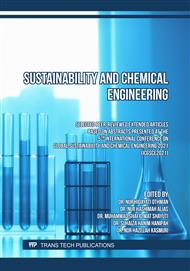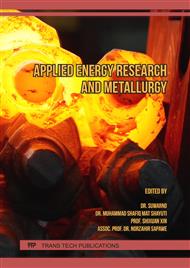[1]
T. R. Sifferman, G. M. Myers, E. L. Haden, and H. A. Wahl, Drill Cutting Transport in Full Scale Vertical Annuli,, 1973.
DOI: 10.2118/4514-ms
Google Scholar
[2]
A. H. Assi, Enhancing the Lifting Capacity of Drilling Fluids in Vertical Oil,, Iraqi Journal of Chemical and Petroleum Engineering, vol. 18, no. 3, p.13–29, (2017).
Google Scholar
[3]
H. Xia, Y. Zhai, and X. Zhang, A Cutting Concentration Calculation Model of a Vertical Wellbore Annulus in Deep-Water Drilling Operation and Its Application,, Applied Mechanics and Materials, vol. 101–102, p.311–314, (2012).
DOI: 10.4028/www.scientific.net/amm.101-102.311
Google Scholar
[4]
M. Kamyab, R. Dawson, and P. Farmanbar, A New Method to Determine Friction Factor of Cuttings Slip Velocity Calculation in Vertical Wells Using Neural Networks,, (2016).
DOI: 10.2118/182359-ms
Google Scholar
[5]
Y. L. Xiang and G. Liu, Impact of Cuttings Concentration on ECD during Drilling,, in AADE Fluids Technical Conference and Exhibition, Hilton Houston North Hotel, Houston, Texas, April10-11, 2012, no. 1.
Google Scholar
[6]
A. Sauki et al., Development of a modified Bourgoyne and Young model for predicting drilling rate,, Journal of Petroleum Science and Engineering, vol. 205,p.108994, (2021).
DOI: 10.1016/j.petrol.2021.108994
Google Scholar
[7]
A. C. Silva Mota, J. M. Santos, A. Silva Rossi, C. R. Duarte, M. S. Pereira, and C. H. Ataíde, Dielectric properties and microwave drying kinetics of drill cuttings contaminated with synthetic drilling fluid,, Drying Technology, vol. 0, no. 0, p.1–12, (2019).
DOI: 10.1080/07373937.2019.1625362
Google Scholar
[8]
API, Recommended Practice on Drilling Fluids Processing Systems Evaluation 13C,, Api, vol. 13501, no. December 2010, (2011).
Google Scholar
[9]
Separation of Drilled Solids from Drilling Fluids - Drilling Fluids,, 2020. https://www.netwasgroup.us/fluids-3/separation-of-drilled-solids-from-drilling-fluids.html (accessed Oct. 30, 2020).
DOI: 10.1016/b978-0-12-821341-4.00015-4
Google Scholar
[10]
American Petroleum Institute, Recommended Practice for Field Testing Water-based Drilling Fluids,, no. Edition, Fifth, (2017).
Google Scholar
[11]
Q. Peng et al., General method of calculating annular laminar pressure drop of drilling fluids with different rheological models,, Petroleum Exploration and Development, vol. 40, no. 6, p.806–810, 2013,.
DOI: 10.1016/s1876-3804(13)60109-3
Google Scholar
[12]
G. V. Chilingarian, S. J. Mazzullo, and H. H. Rieke, Carbonate Reservoir Characterization: A Geologic-Engineering Analysis, Part II,, Carbonate reservoir characterization: a geologic-engineering analysis, part II. p.60–67, (1996).
DOI: 10.1016/s0376-7361(09)70122-0
Google Scholar
[13]
R. E. Grim and H. Kodama, Clay mineral,, Encyclopedia Britannica, no. 20 February 2014, 2014,.
Google Scholar
[14]
AMC, Drilling Fluids Manual,, Amoco Production Company, p.1–14, (1994).
Google Scholar
[15]
O. A. Adekomaya and O. Olafuyi, An experimental study of the effect of contaminants on the flow properties of oil based drilling mud,, vol. 53, p.315–319, Oct. (2011).
Google Scholar
[16]
A. J. Pollard, M. C. J. Maiden, B. Kuipers, G. van den Dobbelsteen, E. Wedege, and L. van Alphen, Rheological Characterization,, Meningococcal Disease, p.131–145, (2003).
DOI: 10.1385/1-59259-149-3:131
Google Scholar
[17]
M. Sarstedt, C. M. Ringle, and J. F. Hair, Handbook of Market Research (Partial Least Squares Structural Equation Modeling), Springer International Publishing, (2017).
DOI: 10.1007/978-3-319-05542-8_15-1
Google Scholar
[18]
J. F. Hair, C. M. Ringle, and M. Sarstedt, PLS-SEM: Indeed a silver bullet,, Journal of Marketing Theory and Practice, vol. 19, no. 2, p.139–152, (2011).
DOI: 10.2753/mtp1069-6679190202
Google Scholar
[19]
M. M. Mukaka, Statistics Corner: A guide to appropriate use of Correlation coefficient in medical research,, Malawi Medical Journal, vol. 24, no. 3, p.69–71, (2012).
Google Scholar



